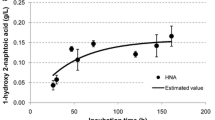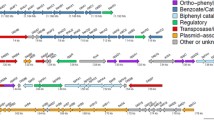Abstract
The phenylacetyl-CoA (Paa) catabolic pathway and genome-wide gene expression responses to phenylacetate catabolism were studied in the polychlorinated biphenyl (PCB)-degrading strain Burkholderia xenovorans LB400. Microarray and RT-qPCR analyses identified three non-contiguous chromosomal clusters of genes that are predicted to encode a complete Paa pathway that were induced up to 40-fold during growth of LB400 on phenylacetate: paaGHIJKR, paaANEBDF, and paaC. Comparison of the available genome sequences revealed that this organization is unique to Burkholderiaceae. Parallel proteomic studies identified 7 of the 14 predicted Paa proteins, most of which were detected only in phenylacetate-grown cells, but not in benzoate- or succinate-grown cells. Finally, the transcriptomic and proteomic analyses revealed the induction of at least 7 predicted catabolic pathways of aromatic compounds and some aromatic plant products (phenols, mandelate, biphenyl, C1 compounds, mevalonate, opine, and isoquinoline), as well as an oxidative stress response and a large group of transporters. Most of these genes were not induced during growth on benzoate or biphenyl, suggesting that phenylacetate or a metabolite may act as a signal that triggers multiple physiological processes. Identifying the components of the Paa pathway is important since the pathway appears to contribute to virulence of Burkholderia pathogens.


Similar content being viewed by others
References
Abe-Yoshizumi R, Kamei U, Yamada A, Kimura M, Ichihara S (2004) The evolution of the phenylacetic acid degradation pathway in bacteria. Biosci Biotechnol Biochem 68:746–748
Altschul SF, Gish W, Miller W, Myers EW, Lipman DJ (1990) Basic local alignment search tool. J Mol Biol 215:403–410
Apweiler R, Attwood TK, Bairoch A, Bateman A, Birney E, Biswas M, Bucher P, Cerutti L, Corpet F, Croning MD, Durbin R, Falquet L, Fleischmann W, Gouzy J, Hermjakob H, Hulo N, Jonassen I, Kahn D, Kanapin A, Karavidopoulou Y, Lopez R, Marx B, Mulder NJ, Oinn TM, Pagni M, Servant F, Sigrist CJ, Zdobnov EM (2001) The InterPro database, an integrated documentation resource for protein families, domains and functional sites. Nucleic Acids Res 29:37–40
Beauchamp CJ, Kloepper JW, Lifshitz R, Dion P, Antoun H (1991) Frequent occurence of the ability to utilize octopine in rhizobacteria. Can J Microbiol 37:158–164
Bedard DL, Unterman R, Bopp BA, Brennan MJ, Haberl ML, Johnson C (1986) Rapid assay for screening and characterizing microorganisms for the ability to degrade polychlorinated biphenyls. Appl Environ Microb 51:761–768
Bopp BA, Sonders RC, Kesterson JW (1986) Toxicological aspects of cyclamate and cyclohexylamine. Crit Rev Toxicol 16:213–306
Chain PS, Denef VJ, Konstantinidis KT, Vergez LM, Agullo L, Reyes VL, Hauser L, Cordova M, Gomez L, Gonzalez M, Land M, Lao V, Larimer F, LiPuma JJ, Mahenthiralingam E, Malfatti SA, Marx CJ, Parnell JJ, Ramette A, Richardson P, Seeger M, Smith D, Spilker T, Sul WJ, Tsoi TV, Ulrich LE, Zhulin IB, Tiedje JM (2006) Burkholderia xenovorans LB400 harbors a multi-replicon, 9.73-Mbp genome shaped for versatility. Proc Natl Acad Sci USA 103:15280–15287
Chavez FP, Lunsdorf H, Jerez CA (2004) Growth of polychlorinated-biphenyl-degrading bacteria in the presence of biphenyl and chlorobiphenyls generates oxidative stress and massive accumulation of inorganic polyphosphate. Appl Environ Microb 70:3064–3072
Coenye T, Vandamme P (2003) Diversity and significance of Burkholderia species occupying diverse ecological niches. Environ Microbiol 5:719–729
Denef VJ, Park J, Tsoi TV, Rouillard JM, Zhang H, Wibbenmeyer JA, Verstraete W, Gulari E, Hashsham SA, Tiedje JM (2004) Biphenyl and benzoate metabolism in a genomic context: outlining genome-wide metabolic networks in Burkholderia xenovorans LB400. Appl Environ Microb 70:4961–4970
Denef VJ, Patrauchan MA, Florizone C, Park J, Tsoi TV, Verstraete W, Tiedje JM, Eltis LD (2005) Growth Substrate- and phase-specific expression of biphenyl, benzoate, and C1 metabolic pathways in Burkholderia xenovorans LB400. J Bacteriol 187:7996–8005
Denef VJ, Klappenbach JA, Patrauchan MA, Florizone C, Rodrigues JL, Tsoi TV, Verstraete W, Eltis LD, Tiedje JM (2006) Genetic and genomic insights into the role of benzoate-catabolic pathway redundancy in Burkholderia xenovorans LB400. Appl Environ Microb 72:585–595
Erickson BD, Mondello FJ (1993) Enhanced biodegradation of polychlorinated biphenyls after site-directed mutagenesis of a biphenyl dioxygenase gene. Appl Environ Microb 59:3858–3862
Ferrandez A, Garcia JL, Diaz E (2000) Transcriptional regulation of the divergent paa catabolic operons for phenylacetic acid degradation in Escherichia coli. J Biol Chem 275:12214–12222
Frantz B, Ngai KL, Chatterjee DK, Ornston LN, Chakrabarty AM (1987) Nucleotide sequence and expression of clcD, a plasmid-borne dienelactone hydrolase gene from Pseudomonas sp. strain B13. J Bacteriol 169:704–709
Gill JF Jr, Beach MJ, Rodwell VW (1985) Mevalonate utilization in Pseudomonas sp. M. Purification and characterization of an inducible 3-hydroxy-3-methylglutaryl coenzyme A reductase. J Biol Chem 260:9393–9398
Goris J, De Vos P, Caballero-Mellado J, Park J, Falsen E, Quensen JF 3rd, Tiedje JM, Vandamme P (2004) Classification of the biphenyl- and polychlorinated biphenyl-degrading strain LB400T and relatives as Burkholderia xenovorans sp. nov. Int J Syst Evol Microbiol 54:1677–1681
Habeeb LF, Wang L, Winans SC (1991) Transcription of the octopine catabolism operon of the Agrobacterium tumor-inducing plasmid pTiA6 is activated by a LysR-type regulatory protein. Mol Plant Microbe Interact 4:379–385
Hamlin JN, Bloodworth RA, Cardona ST (2009) Regulation of phenylacetic acid degradation genes of Burkholderia cenocepacia K56-2. BMC Microbiol 9:222
Ismail W, El-Said Mohamed M, Wanner BL, Datsenko KA, Eisenreich W, Rohdich F, Bacher A, Fuchs G (2003) Functional genomics by NMR spectroscopy. Phenylacetate catabolism in Escherichia coli. Eur J Biochem 270:3047–3054
Jimenez JI, Minambres B, Garcia JL, Diaz E (2004) Genomic insights in the metabolism of aromatic compounds in Pseudomonas. In: Ramos J-L (ed) Pseudomonas. Kluwer, New York, pp 425–463
Kim IS, Lee H, Trevors JT (2001) Effects of 2, 2′, 5, 5′-tetrachlorobiphenyl and biphenyl on cell membranes of Ralstonia eutropha H850. FEMS Microbiol Lett 200:17–24
Law RJ, Hamlin JN, Sivro A, McCorrister SJ, Cardama GA, Cardona ST (2008) A functional phenylacetic acid catabolic pathway is required for full pathogenicity of Burkholderia cenocepacia in the Caenorhabditis elegans host model. J Bacteriol 190:7209–7218
Lehman-McKeeman LD, Caudill D (1994) d-Limonene induced hyaline droplet nephropathy in alpha 2u-globulin transgenic mice. Fundam Appl Toxicol 23:562–568
Luengo JM, Garcia JL, Olivera ER (2001) The phenylacetyl-CoA catabolon: a complex catabolic unit with broad biotechnological applications. Mol Microbiol 39:1434–1442
McLeod MP, Eltis LD (2008) Genomic insights into the aerobic pathways for degradation of organic pollutants. In: Diaz E (ed) Microbial biodegradation: genomics, molecular biology. Horizon Scientific Press, Norfolk, pp 1–23
Navarro-Llorens JM, Patrauchan MA, Stewart GR, Davies JE, Eltis LD, Mohn WW (2005) Phenylacetate catabolism in Rhodococcus sp. strain RHA1: a central pathway for degradation of aromatic compounds. J Bacteriol 187:4497–4504
Olivera ER, Minambres B, Garcia B, Muniz C, Moreno MA, Ferrandez A, Diaz E, Garcia JL, Luengo JM (1998) Molecular characterization of the phenylacetic acid catabolic pathway in Pseudomonas putida U: the phenylacetyl-CoA catabolon. Proc Natl Acad Sci USA 95:6419–6424
Parnell JJ, Park J, Denef V, Tsoi T, Hashsham S, Quensen J 3rd, Tiedje JM (2006) Coping with polychlorinated biphenyl (PCB) toxicity: physiological and genome-wide responses of Burkholderia xenovorans LB400 to PCB-mediated stress. Appl Environ Microbiol 72:6607–6614
Parnell JJ, Denef VJ, Park J, Tsoi T, Tiedje JM (2010) Environmentally relevant parameters affecting PCB degradation: carbon source- and growth phase-mitigated effects of the expression of the biphenyl pathway and associated genes in Burkholderia xenovorans LB400. Biodegradation 21:147–156
Patrauchan MA, Florizone C, Dosanjh M, Mohn WW, Davies J, Eltis LD (2005) Catabolism of benzoate and phthalate in Rhodococcus sp. strain RHA1: redundancies and convergence. J Bacteriol 187:4050–4063
Patrauchan MA, Florizone C, Eapen S, Gomez-Gil L, Sethuraman B, Fukuda M, Davies J, Mohn WW, Eltis LD (2008) Roles of ring-hydroxylating dioxygenases in styrene and benzene catabolism in Rhodococcus jostii RHA1. J Bacteriol 190:37–47
Rodrigues JL, Kachel CA, Aiello MR, Quensen JF, Maltseva OV, Tsoi TV, Tiedje JM (2006) Degradation of aroclor 1242 dechlorination products in sediments by Burkholderia xenovorans LB400(ohb) and Rhodococcus sp. strain RHA1(fcb). Appl Environ Microbiol 72:2476–2482
Sauter M, Tshisuaka B, Fetzner S, Lingens F (1993) Microbial metabolism of quinoline and related compounds. XX. Quinaldic acid 4-oxidoreductase from Pseudomonas sp. AK-2 compared to other procaryotic molybdenum-containing hydroxylases. Biol Chem Hoppe Seyler 374:1037–1046
Stephan I, Tshisuaka B, Fetzner S, Lingens F (1996) Quinaldine 4-oxidase from Arthrobacter sp. Ru61a, a versatile procaryotic molybdenum-containing hydroxylase active towards N-containing heterocyclic compounds and aromatic aldehydes. Eur J Biochem 236:155–162
Tamburro A, Robuffo I, Heipieper HJ, Allocati N, Rotilio D, Di Ilio C, Favaloro B (2004) Expression of glutathione S-transferase and peptide methionine sulphoxide reductase in Ochrobactrum anthropi is correlated to the production of reactive oxygen species caused by aromatic substrates. FEMS Microbiol Lett 241:151–156
Teufel R, Mascaraque V, Ismail W, Voss M, Perera J, Eisenreich W, Haehnel W, Fuchs G (2010) Bacterial phenylalanine and phenylacetate catabolic pathway revealed. Proc Natl Acad Sci USA 107:14390–14395
Tomas-Gallardo L, Canosa I, Santero E, Camafeita E, Calvo E, Lopez JA, Floriano B (2006) Proteomic and transcriptional characterization of aromatic degradation pathways in Rhodoccocus sp. strain TFB. Proteomics 6(Suppl 1):S119–S132
Utsumi R, Yagi T, Katayama S, Katsuragi K, Tachibana K, Toyoda H, Ouchi S, Obata K, Shibano Y, Noda M (1991) Molecular cloning and characterization of the fusaric acid-resistance gene from Pseudomonas cepacia. Agric Biol Chem 55:1913–1918
Van Dyk TK, Templeton LJ, Cantera KA, Sharpe PL, Sariaslani FS (2004) Characterization of the Escherichia coli AaeAB efflux pump: a metabolic relief valve? J Bacteriol 186:7196–7204
Yoder-Himes DR, Chain PSG, Zhu Y, Wutzel O, Rubin EM, Tiedje JM, Sorek R (2008) Mapping the Burkholderia cenocepacia niche response via high-throughput sequencing. Proc Natl Acad Sci USA 106:3976–3981
Acknowledgments
This work was supported by Genome Canada and an NSERC Discovery Grant to LDE, and by the Superfund Basic Research Program grant P42 ES 04911-20 from the U.S. National Institute of Environmental Health Sciences. Jeff Landgraf assisted with RT-qPCR analysis.
Author information
Authors and Affiliations
Corresponding author
Additional information
Communicated by Shuang-Jiang Liu.
The authors Marianna A. Patrauchan and J. Jacob Parnell contributed equally.
Electronic supplementary material
Below is the link to the electronic supplementary material.
Rights and permissions
About this article
Cite this article
Patrauchan, M.A., Parnell, J.J., McLeod, M.P. et al. Genomic analysis of the phenylacetyl-CoA pathway in Burkholderia xenovorans LB400. Arch Microbiol 193, 641–650 (2011). https://doi.org/10.1007/s00203-011-0705-x
Received:
Revised:
Accepted:
Published:
Issue Date:
DOI: https://doi.org/10.1007/s00203-011-0705-x




